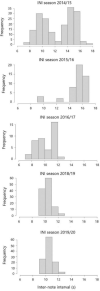Occurrence and patterns of fin whale songs reveal alternative migration strategies in Svalbard Islands, Norway
- PMID: 36932235
- PMCID: PMC10023778
- DOI: 10.1038/s41598-023-31665-x
Occurrence and patterns of fin whale songs reveal alternative migration strategies in Svalbard Islands, Norway
Abstract
The Arctic marine environment is highly affected by global warming with notable changes in habitat conditions, which have great consequences on migrating species. For example, the timing of their migration can be altered leading to changes in their occurrence in suitable areas, which are critical for their survival. In this study, seven years of acoustic data were analysed in Svalbard Islands from 2014 to 2020, revealing that the occurrence of fin whales (Balaenoptera physalus) happened all year-round. The sea surface temperature recorded reveals conditions which could be favorable for these species to persist until the Polar Night. The occurrence of songs indicated that certain individuals did not undertake the migratory journey through the southern breeding grounds, possibly using the area for mating purposes. The analyses of the Inter-Note-Interval (INI) demonstrated that over the years songs with different patterns were found. This suggests that either the fin whales are able to switch their INI patterns or that populations with different INIs are visiting during the Winter. Therefore, this study unveils the undertaking of an alternative strategy to migration movements, and the possible potential origin of the fin whales overwintering in Svalbard.
© 2023. The Author(s).
Conflict of interest statement
The authors declare no competing interests.
Figures







Similar articles
-
A multi-year analysis of acoustic occurrence and habitat use of blue and fin whales in eastern and central Fram Strait.PLoS One. 2024 Nov 26;19(11):e0314369. doi: 10.1371/journal.pone.0314369. eCollection 2024. PLoS One. 2024. PMID: 39591459 Free PMC article.
-
Fin whale song characteristics and potential subpopulation identity in the New York Bight.Sci Rep. 2024 Feb 13;14(1):2931. doi: 10.1038/s41598-024-52228-8. Sci Rep. 2024. PMID: 38351184 Free PMC article.
-
Autumn movements of fin whales (Balaenoptera physalus) from Svalbard, Norway, revealed by satellite tracking.Sci Rep. 2020 Oct 12;10(1):16966. doi: 10.1038/s41598-020-73996-z. Sci Rep. 2020. PMID: 33046805 Free PMC article.
-
Fin Whales, Balaenoptera physalus: At Home in a Changing Mediterranean Sea?Adv Mar Biol. 2016;75:75-101. doi: 10.1016/bs.amb.2016.08.002. Epub 2016 Sep 24. Adv Mar Biol. 2016. PMID: 27770993 Review. No abstract available.
-
Is it 'boom times' for baleen whales in the Pacific Arctic region?Biol Lett. 2016 Sep;12(9):20160251. doi: 10.1098/rsbl.2016.0251. Biol Lett. 2016. PMID: 27601724 Free PMC article. Review.
Cited by
-
Discrimination Factor of Sulphur Stable Isotope Ratios Between Pregnant Fin Whales and Their Foetuses.Rapid Commun Mass Spectrom. 2025 Jul 30;39(14):e10057. doi: 10.1002/rcm.10057. Rapid Commun Mass Spectrom. 2025. PMID: 40292488 Free PMC article.
-
Fin whale song evolution in the North Atlantic.Elife. 2024 Jan 9;13:e83750. doi: 10.7554/eLife.83750. Elife. 2024. PMID: 38192202 Free PMC article.
-
Fin whale song recordings by onshore seismometers open new horizons for cetacean coastal monitoring.Sci Rep. 2025 Apr 18;15(1):13475. doi: 10.1038/s41598-025-97638-4. Sci Rep. 2025. PMID: 40251203 Free PMC article.
References
-
- Huntington HP, et al. Evidence suggests potential transformation of the Pacific Arctic ecosystem is underway. Nat. Clim. Change. 2020;10(4):342–348. doi: 10.1038/s41558-020-0695-2. - DOI
-
- MacLeod CD. Global climate change, range changes and potential implications for the conservation of marine cetaceans: A review and synthesis. Endanger. Species Res. 2009;7(2):125–136. doi: 10.3354/esr00197. - DOI
-
- Moore SE. Marine mammals as ecosystem sentinels. J. Mammal. 2008;89(3):534–540. doi: 10.1644/07-MAMM-S-312R1.1. - DOI
-
- Storrie L, Lydersen C, Andersen M, Wynn RB, Kovacs KM. Determining the species assemblage and habitat use of cetaceans in the Svalbard Archipelago, based on observations from 2002 to 2014. Polar Res. 2018;2018:37.
Publication types
MeSH terms
LinkOut - more resources
Full Text Sources

